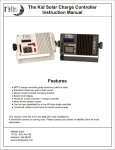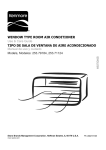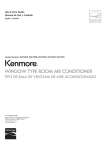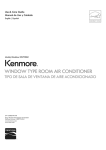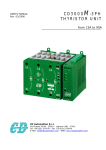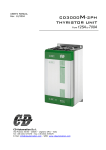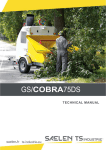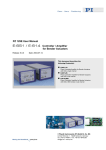Download 1990 Troy-Bilt Trail Blazer Sickle bar Mower
Transcript
o T-."D~BILT Technical Manual Trail Blazer® Sicklebar Mower GARDEN WAY INC. TRAIL BLAZER MOWER TECHNICAL MANUAL Page 2 3/90 TABLE OF CONTENTS Page No. 2 SECTION 1: General Information Safety First Quick Reference Guide....... Taking the Mower Out of Storage 4 6 SECTION 2: Pre-Service Inspection 8 SECTION 3: Servicing the Mower 9 Servicing the Drive Arm Disassembling the Drive Arm Inspecting the Drive Arm 9 9 9 7 ; Assembling the Drive Arm.................................. 9 Installing the Drive Arm................................................................................................................. 9 Servicing the Wheel Shaft 11 Removing the Wheel Shaft 11 Inspecting the Wheel Shaft 11 Drive Belt 11 Checking the Wheel Shaft for Play 11 Installing the Wheel Shaft. 11 Servicing the Jackshaft 12 Removing the Jackshaft 12 Inspecting the Jackshaft 12 Jackshaft Sprocket 12 Checking the Jackshaft for Play 12 Installing the Jackshaft 12 Servicing the Flywheel 13 Removing the Flywheel Bearings 13 Removing the Flywheel Assembly 13 Inspecting the Flywheel 13 Bearings 14 Cutter Bar Drive Belt 14 Flywheel Pin 14 Flywheel Bolt 14 Installing the Flywheel Assembly 14 Removing and Installing the Engine 14 Removing the Engine 14 Installing the Engine 15 Servicing the Engine Oil Drain Tube and Cap 15 INDEX 17 SECTION 1: GENERAL INFORMATION • This Manual provides service information for the TRAIL SLAZER® Sickle Sar Mower built by TROY- . SILT Manufacturing Company, Troy, New York. Use this Manual for mowers with serial number Y00001 00 and up. • All information, illustrations, and specifications contained in this Manual are based on the latest information available at the time of publication. The right is reserved to make changes at any time without notice. If you have any questions concerning the information contained in this Manual, please contact: Technical Service Department TROY-SILT Manufacturing Company 102nd St. & 9th Ave. Troy, New York 12180 Call Toll-Free: 1-800-833-6990 This symbol is used to alert you to important safety . . messages in this Technical Manual, in the Owner/Operator Manual, and on decals affixed to the mower. When you see this symbol, carefully read and follow its safety message. Failure to do so could result in personal injury or property damage. A • This Manual is divided into three sections as shown in the Table of Contents. For best results, read each section in its entirety before performing the procedure. • This Technical Manual is designed to be used in combination with the Owner/Operator Manual. The Owner/Operator Manual contains additional service and maintenance information that is not covered in this TRAIL BLAZER MOWER TECHNICAL MANUAL Page 3 3/90 Technical Manual. Refer to the "Quick Reference Guide" on Page 6 for a listing of the service and maintenance topics that are covered in the Owner/Operator Manual. • Service and maintenance information regarding engines is not covered in this Manual. Such information can be obtained by consulting the Service Repair Manuals available from the engine manufacturer. You should, however, call our Technical Service Department with questions concerning engine replacement. • Throughout this Manual, you will see references to the left and right side of the mower. This refers to the left and right sides of the mower as you would see them when you are standing in the operator's position. TRAIL BLAZER MOWER TECHNICAL MANUAL Page 4 3/90 SECTION 1: GENERAL INFORMATION Safety First! When working on the mower or its engine, closely follow operating instructions and safety practices at all times. Failure to do so could result in personal injury or property damage. Here are some basic safety precautions you should keep in mind at all times when doing repair work: KNOW THE MOWER AND ENGINE! Read the Owner/Operator Manual carefully. Be sure you know what each mower and engine control does before you attempt to operate it. Read and follow all safety rules. Never allow inexperienced persons or children to operate the mower or its engine. WEAR PROPER APPAREL! Don't wear loose clothing or jewelry that could get caught in moving parts of the mower or its engine. AVOID MOVING PARTS! Keep hands, feet, hair, clothing, and tools safely away from moving parts when the engine is running. AVOID ACCIDENTAL STARTING! Prevent unintentional starting by disconnecting the spark plug wire and keeping the wire away from the spark plug. Place engine controls in the OFF position and make sure that both handlebar levers are not engaged (make sure they are released). WEAR EYE PROTECTION! Safety goggles or a face shield should be worn whenever there is the possibility of danger to the eyes from flying parts or particles. PREVENT FIRES AND EXPLOSIONS! Gasoline is highly flammable and explosive. It should be used and stored with extreme caution. Keep gasoline away from open flames and sparks. Do not smoke near gasoline cans or fuel tanks. Do not add gasoline to a fuel tank when the engine is running or still hot (wait until the engine has cooled before adding fuel). Fill the fuel tank outdoors in a well-ventilated area. Store gasoline in a cool, well-ventilated place, safely away from any spark or flame producing equipment. Store only in a U.L. approved container. Make sure this container is safely out of reach of children. Wipe off any spilled gasoline and move the engine away from gasoline fumes before starting the engine. Use cleaning solvents only according to recognized safety practices (never use gasoline as a cleaning solvent). Oily rags and waste should be packed in a U.L. approved covered metal safety container to prevent fire from spontaneous combustion. HANDLE BATTERIES WITH CARE! Do not charge the battery while the engine is running or hot. Before charging the battery, disconnect the spark plug wire and make sure it cannot accidentally touch the spark plug during charging. Also remove the engine ignition key from the keyswitch (electric start models only). Use only the battery charger provided with the mower. Do not allow the battery wires to touch each other. Do not allow a metal object that is in contact with a battery wire to touch another metal object that is in contact with the other battery wire. Do not place the battery in an airtight container when charging the battery. Remove all rings and metal jewelry when working on the battery or electrical system. AVOID ENGINE EXHAUST FUMES! Do not run the engine in an enclosed area. Exhaust gases contain carbon monoxide, an odorless and deadly poison. Provide adequate ventilation at all times. After running the engine, don't touch the muffler or other hot engine parts until they have cooled down. HANDLE PARTS CAREFULLY! With continued use, the teeth on sprockets or other moving parts may wear to sharp, knife-like edges. Therefore, when handling these parts, always use care to avoid cutting yourself. USE GENUINE TROY-BILT REPLACEMENT PARTS! Replacement parts manufactured by others could present safety hazards even though they may fit on this mower. KEEP UNAUTHORIZED PERSONNELAWAY! Keep the area of operation clear of all persons (particularly small children) and pets. Stop both the cutter bar blade and the wheel drive when you are approached by any child, inattentive person, or pet. LEAVE GUARDS AND SAFETY DEVICES IN PLACE! Never attempt to disconnect or remove guards or other safety devices, or to defeat the purpose of them. CHECK OPERATION OF HAND LEVERS BEFORE EACH USE! Before each use, check the operation of the handlebar levers. See Section 4, Mower Operation, in the Owner/Operator Manual for specific instructions. Do not use the mower if either handlebar lever is not functioning properly. SECTION 1: GENERAL INFORMATION KEEP CHILDREN AWAY WHEN OPERATING THE MOWER! Keep children out of the mowing area. Keep them under the watchful eye of an adult other than the person operating the mower. Never assume that children will remain where you last saw them. LOOK BEHIND WHEN BACKING THE MOWER UP! Before you back the mower up, and while you're backing it up, be sure to look behind you for small children. KEEP HANDS AND FEET AWAY FROM MOVING PARTS! Do not put hands or feet near or under any moving parts. Keep clear of the cutter bar at all times when the engine is running. TRAIL BLAZER MOWER TECHNICAL MANUAL Page 5 3/90 SHUT MOWER OFF WHEN PERFORMING ANY MAINTENANCE! Before inspecting, cleaning, adjusting, or repairing the mower or cutter bar: 1) stop the engine, 2) disconnect the spark plug wire and prevent it from touching the spark plug, 3) wait for all moving parts to stop, and 4) reinstall the plastic blade protector on the blade. On electric start models, also remove the Engine Ignition key from the keyswitch. TRAIL BLAZER MOWER TECHNICAL MANUAL Page 6 3/90 SECTION 1: GENERAL INFORMATION Quick Reference Repair Index Information on the following topics can be found in the TRAIL BLAZER® Owner/Operator Manual: Air Filter Air Pressure, Tires Battery Removal Belts Cutter Bar Wheel Drive (See this Technical Manual for additional information.) Blade Drive Lever Blade Guide Adjustment Carburetor Adjustment1 Cutter Bar Adjustment Assembly Removing Drive Arm Removal Installation (See this Technical Manual for additional information.) Engine 1 Ignition Switch (See this Technical Manual for additional information.) Throttle Lever Fuel Grease Points Handlebar Height Adjustment Lubrication Points Motor Oil Oil Operation Ordering Parts PreStart Checklist Recoil Starter Spark Plug 1 Specifications 1 Starting Storage for Off-Season Throttle Lever, Engine Tire Pressure Troubleshooting Wheel Drive Lever Wheel Shaft Removal (In Section 5 of the Owner/Operator Manual, "Removing and Installing the Wheel Drive Belt", removal Steps 1 through 10) Installation (In Section 5 of the Owner/Operator Manual," Removing and Installing the Wheel Drive Belt", installation Steps 4 through 12) (See this Technical Service Manual for addition al information.) Jackshaft Removal (In Section 5 of the Owner/Operator Manual, "Removing and Installing the Wheel Drive Belt" removal steps 1 through 10) Installation (In Section 5 of the Owner/Operator Manual, "Removing and Installing the Wheel Drive Belt", installation Steps 4 through 12) (See this Technical Manual for additional in for mation) Information on the following topics can be found in this TRAIL BLAZER® Technical Manual: Cutter Bar Drive Belt Guide Rubber Bushing and Drive Pin (See the Owner/Operator Manual for more information.) Drive Arm Assembly Disassembly Inspecting (See the Owner/Operator Manual for more information.) Engine Removal Drain Tube and Cap Replacement (See the Owner/Operator Manual for more information.) Flywheel Jackshaft Checking For Play Inspecting Shimming Pre-Service Inspection Weed Deflector and Support Wheel Shaft Checking For Play Inspecting Shimming (See the Owner/Operator Manual for more information.) 1 Also see Engine Owner's Manual. SECTION 1: GENERAL INFORMATION TRAIL BLAZER MOWER TECHNICAL MANUAL Page 7 3/90 Taking the Mower Out 0-' Storage The following instructions explain what you must do in order to ready a TRAIL BLAZER® Mower for use after it has been stored according to the storage instructions in the Owner/Operator Manual. 1. Charge the battery. See Section 5 of the Owner/Operator Manual for instructions. 2. Thoroughly inspect the mower for any loose, broken, or missing components. Repair them as necessary. 3. Check all bolts to ensure that they are tight. 4. Add fuel to the fuel tank. 5. Check the oil level, adding oil inecessary. 6. Remove the spark plug. 7. Inspect the spark plug to see if any oil is present on the plug's electrode. If the plug is fouled, clean it or replace it. Then reinstall the plug. 8 Make sure the spark plug wire is securely connected to the spark plug. 9 Check the tire pressure. The tires should have a pressure of 10 to 20 PSI. Equally inflate or deflate the tires as necessary Don't over-inflate the tires .. NOTE: After you start the engine, you may see white smoke. This is the oil in the cylinder burning off. This white smoke will soon disappear. TRAIL BLAZER MOWER TECHNICAL MANUAL Page 8 3/90 A SECTION 2: PRE-SERVICE INSPECTION WARNING: When servicing the mower, prevent unintentional starting of the engine by disconnecting the spark plug wire and keeping the wire away from the spark plug. Place the engine throttle lever in its OFF position and make sure that the two handlebar levers are released. Engine Oil Drain Tube and Cap Fill the engine with oil to see if oil leaks from the engine oil drain tube/cap. If oil leaks from this area, use a pair of pliers to tighten the tube. Then tighten the cap. Be careful not to over-tighten the oil tube; it is possible to strip the aluminum threads in the engine. If oil still leaks after you tighten the tube and cap, remove the cap and drain the oil. See Servicing the Engine Oil Drain Tube and Cap in this manual for reinstallation instructions. Wheel Assembly Push the mower forward and backward. The mower should roll easily. If the wheels do not move easily, make sure the wheel drive cable is not adjusted too tight. (See the Owner/Operator Manual for instructions. Also make sure that the wheels are not obstructed. Spark Arrester Make sure the spark arrester is not damaged or rusted. Cable Guard Make sure the cable guard (below the engine deck) is not bent and pinching the blade drive cable. Decals Make sure all of the following decals are present and readable. Replace any decals that are missing or unreadable. • A blade drive lever decal in front of the right hand grip. • A control panel operating instructions/warning decal on the control panel between the handlebars. • A wheel drive lever decal in front of the left hand grip. • A stabilization decal in front of the left hand grip. • A danger decal on the weed deflector. • A danger decal on the hood. • A single danger decal on the forward portion of each side plate. • An oil drain location decal on the left-hand side of the engine deck plate. • A warning decal on the wheel drive belt cover. • An engine ignition switch identification decal near the keyswitch (for electric start models only). • A battery instruction/warning decal on the rear hood (electric start models only). • A TRAIL BLAZER® Mower logo decal on the hood. Tires Make sure that the tires are equally inflated to 10-20 PSI. Make sure that both tires are in good condition. Also make sure that the hair pin cotter and the clevis pin are in place in both wheel hubs. Cables Make sure that the blade drive cable and wheel drive cable are not crimped. Make sure both levers move freely and that the cables are adjusted properly. Make sure that the throttle cable is connected to the engine and that it operates properly. Cutter Bar • Make sure all rivets on the cutter bar are in place and securely attached. • Make sure all the blades are in place. • Make sure the blades are tight. See the Owner/Operator Manual for tightening instructions. • Make sure the bolts that hold the cutter bar mounts are tightly secured. • Make sure the nuts that secure the height adjuster to the back of the ledger bar are tight. • Make sure the drive pin is securely fastened to the cutter bar. Grease Fittings Make sure the two grease fittings on the cutter bar support and the one on the drive arm assembly are in place and in good condition. SECTION 3: SERVICING THE MOWER TRAIL BLAZER MOWER TECHNICAL MANUAL Page 9 3/90 This section, SERVICING THE MOWER,discusses repair procedures that are not included in the TRAIL BLAZER® Mower Owner/Operator Manual. A WARNING: When servicing the mower, prevent unintentional starting of the engine by discon- ~ necting the spark plug wire and keeping the wire away from the spark plug. Place the engine throttle lever in its OFF position and make sure that the two handlebar levers are released. Servicing the Drive Arm These instructions describe how to service the drive arm assembly. See Figure 1 as a reference for part locations in these instructions. should also inspect any replacement See Section 5 of the Drive Socket Holder parts you will use. Owner/Operator Manual, Cutter Bar Make sure the hole in the drive Drive Belt Removal and Installation, socket holder has not expanded. Steps 1 through 5 under removal for NOTE: Thoroughly degrease and Insert a new drive socket in the drive instructions on removal of the drive clean all parts (except the bearings) socket holder and move the socket arm assembly. before inspection. back and forth. If you find more than .020" play, replace the drive arm. Disassembling the Drive Arm Channel Bolt Holes You would disassemble the drive arm to replace the drive arm pivot bearings and drive arm spacer. To find out if the bearings and spacer need to be replaced, grab the drive arm near the pivot point and rock the drive arm side to side and check for play. See Figure 2 for an illustration. The four channel bolt holes should be just large enough to fit the bolt. Replace the drive arm if the bolt holes have elongated. Also, there should be no cracks in the drive arm leading out from the channel bolt holes. Replace the drive arm if there are any fatigue cracks. You must first remove the drive arm before proceeding with these instructions. Channel 1. Remove the lower (internal) snap ring (1) that retains the drive arm pivot bearings. 2. Remove the upper (internal) snap ring (2) that retains the drive arm pivot bearings. 3. Remove the two drive arm pivot bearings (3) and the drive arm spacer (4). You may be able to remove these bearings by hand or you may have to carefully press them out. Inspecting the Drive Arm These instructions describe how to inspect vital parts on the drive arm assembly. In addition to inspecting the parts you have removed, you Check the entire channel for cracks. If the channel has any cracks, replace it. Grease Fitting Make sure the grease fitting on the front of the drive arm is in place. Grease the fitting to make sure it works correctly. You should see grease coming out of the tube on the front of the driv.e arm after two pumps of the grease gun. Welds Inspect the welds that hold the drive socket holder and the bearing retainer to the drive arm. Make sure the welds are sound - that there are no cracks in them. Assembling the Drive Arm. 1. Install the lower drive arm pivot bearing (3). You may be able to push the bearing in by hand or you may need to press it in. Since this is a sealed bearing, it does not need to be lubricated. 2. Install the drive arm spacer (4) 3. Install the upper drive arm pivot bearing (3). You may be able to push the bearing in by hand or you may need to press it in. Since this is a sealed bearing, it does not need to be lubricated. 4. Install the upper (internal) snap ring (2) that retains the drive arm pivot bearings. 5. Install the lower (internal) snap ring (1) that retains the drive arm pivot bearings. Installing the Drive Arm See Section 5 of the Owner/Operator Manual, Cutter bar Drive Belt Removal and Installation, Steps 6 through 9 for drive arm assembly installation instructions. TRAIL BLAZER MOWER TECHNICAL MANUAL Page 10 3/90 SECTION 3: SERVICING THE MOWER Figure 1: Drive Arm Assembly. Figure 2: Testing the Drive Arm Pivot Bearing. SECTION 3: SERVICING THE MOWER TRAIL BLAZER MOWER TECHNICAL MANUAL Page 11 3/90 Servicing the Wheel Shaft. These instructions describe servicing the wheel shaft. See Figure 3 as a reference for part locations in these instructions. The numbers in parenthesis refer to item numbers in the figure. Removing the Wheel Shaft See Section 5 of the Owner/Operator Manual, Removing the Wheel Drive Belt, Steps 1 through 10 under removal, for instructions on how to remove the wheel shaft. Inspecting the Wheel Shaft These instructions describe the inspection of vital parts on the wheel shaft assembly. In addition to inspecting the parts you have removed, you should also inspect any replacement parts you will use. NOTE: Thoroughly degrease and clean all parts (except the belt) before inspection. Drive Belt The belt should not be frayed, stretched, or excessively worn. Look at the belt near the idler pulley. If the two sides of the belt are touching or are nearly touching, replace the belt. Figure 3: Wheel Shaft and Jackshaft. See Figure 4. Engage the Wheel Drive Lever. If the belt is properly adjusted, the belt should be under tension. If the belt is slack while you are pressing the Wheel Drive Lever, readjust the wheel drive system. If there is no further adjustment in both adjusters, replace the belt. (See the Owner/Operator Manual.) Wheel Shaft Sprocket Check for signs of sprocket wear If the sprocket is worn, the chain should also be replaced. Checking the Wheel Shaft for Play After you install the wheel shaft, check it for play. • Check the wheel shaft for end play. There should be no more than .030" end play. The wheel shaft should spin freely. Add shims (1) as necessary to obtain this tolerance. • Grab the wheel shaft and try to move it forward and backward and up and down. If the wheel shaft moves at all, you should replace the axle bushing (1). If play is present after replacing the bushing, inspect the wheel shaft section that rests in the bushing; it may be worn. If the wheel shaft is worn in this area, replace the wheel shaft. Installing the Wheel Shaft See Section 5 of the Owner/Operator Manual, Cutter Bar Drive Belt Removal and Installation, Steps 5 through 11 under installation for instructions on drive arm assembly installation. TRAIL BLAZER MOWER TECHNICAL MANUAL Page 12 3/90 SECTION 3: SERVICING THE MOWER Servicing the Jackshaft These instructions describe how to service the jackshaft. See Figure 3 as a reference for part locations in these instructions. after replacing the bushing, inspect Removing the Jackshaft Jackshaft Sprocket the jackshaft section that rests in the Check for signs of sprocket wear. See Section 5 of the bushing; it may be worn. If the secIf the sprocket must be replaced, Owner/Operator Manual, Removing tion of the jackshaft that rests in the also replace the chain. and Installing the Wheel Drive Belt, bushing is worn, replace the jackSteps 1 through 10 under removal shaft. for instructions on jackshaft removal. Checking the Jackshaft for Play Inspecting the Jackshaft These instructions describe inspecting vital parts of the jackshaft assembly. In addition to inspecting the parts you have removed, you should also inspect any replacement parts you will use. NOTE: Thoroughly degrease and clean all parts before inspection. • After you install the jackshaft, check it for play. • Check the jackshaft for end play. There should be no more than .030" end play. Also, the jackshaft should spin freely. Add shims (2) as necessary to obtain this tolerance. Grasp the jackshaft and try to move it forward and backward and up and down. If the jackshaft moves more than .030" you should replace the bushing (3). If play is present Installing the Jackshaft See Section 5 of the Owner/Operator Manual, Removing and Installing the Wheel Drive Belt, Steps 4 through 12 for jackshaft installation instructions. Jackshaft Pulley PTO Pulley Figure 4: Checking Wheel Drive Belt Wear. SECTION 3: SERVICING THE MOWER TRAIL BLAZER MOWER TECHNICAL MANUAL Page 13 3/90 Servicing the Flywheel These instructions describe how to service the flywheel. You would check the bearing on the flywheel if, when engaging the Blade Drive Lever, you hear a knocking noise, which indicates that the bearings are bad. See Figure 6 as a reference for part locations in these instructions. The numbers in parenthesis refer to item numbers in the figure. Removing the Flywheel Bearings remove the bearing by hand. Then remove the flywheel pin shim (10). There are two kinds of bearings on the flywheel: Removing the Flywheel Assembly Flywheel Bearing The flywheel has to be removed to remove this bearing. You can remove this bearing by hand. Then remove the flywheel shim (7). Eccentric Bearing You can remove the bearing while the flywheel is still in the mower. To remove this bearing you must first take off the snap ring (9). Then 1. Remove the drive arm. See Section 5 of the Owner/Operator Manual, Cutter Bar Drive Belt Removal and Installation, Steps 1 through 5 under removal. 2. Remove the bolts (1) that secure the cutter bar drive belt cover (2) to the mower. Then remove the cutter bar drive belt cover. 3. Remove the left side belt guide pin. 4. Lift the cutter bar drive belt over the flywheel. If the tension on the flywheel belt is such that you cannot lift the belt over the flywheel, relax the tension on the belt by loosening the upper or lower cutter bar drive cable adjusters. See Section 5 of the Owner/Operator Manual, Cutter Bar Drive Initial Setting, Steps 1 and 3. 5. Put a wrench on the flywheel retaining nut (3) and hold the nut '--,0 Figure 5: The Flywheel Installation. while you put another wrench on the flywheel bolt (4). Then remove the nut and bolt. 6. Discard the flat washer (5). 7. Lift the flywheel off. 8. Remove the flywheel bearing (6) and discard the flywheel shim (7). 9. Remove the (external) snap ring (8) that retains the eccentric bearing. 10. Remove the eccentric bearing (9) and discard the flywheel pin shim (10). Inspecting the Flywheel These instructions describe how to inspect vital parts on the flywheel assembly. In addition to inspecting the parts you have removed, you should also inspect any replacement parts you will use. NOTE: Thoroughly degrease and clean all parts (except the bearings) before inspection. TRAIL BLAZER MOWER TECHNICAL MANUAL Page 14 3/90 SECTION 3: SERVICING THE MOWER Bearings Flywheel Pin If a bearing has a bluish color it indicates a lack of lubrication; replace the bearing. Both bearings are a press fit - it is easier to check them on the flywheel before pressing them out. Check the eccentric bearing by turning its outside race with your fingers. Check the flywheel bearings by rotating the flywheel by hand. However, if you have already removed the bearings check them as follows: Pinch the bearing's inner race and spin it. If you hear a growling noise, if the bearing doesn't spin, if the bearing feels tight or if the bearing wobbles as it spins, replace the bearing. Make sure the pin on which the eccentric bearing sits has no rough edges or burrs. Check the pin and the casting around the pin for cracks. Use a piece of 200 grit emery cloth, if necessary, to smooth the pin. Then apply a small amount of grease to the pin to hellp prevent rust. Cutter Bar Drive Belt This inspection must be performed before you remove the flywheel. Engage the Blade Drive Lever and observe the belt. If the belt is not under tension and the blade drive cable is properly adjusted, then the belt has stretched and you must replace it. See Section 5, Cutter Bar Belt Drive Removal and Installation, in the Owner/Operator Manual for instructions. Also check the belt for cracks and wear. Flywheel Bolt Make sure there are no flat spots on the bolt (4) that holds the flywheel. If there are any flat spots, replace the bolt. Also, make sure the threads on the bolt are not stripped. Thoroughly check the flywheel bolt for any cracks or signs of deterioration. Replace a damaged bolt. Installing the Flywheel Assembly 1. Install a new flywheel pin shim (10). 2. Press fit the eccentric bearing (9). 3. Install the (external) snap ring (8) that retains the eccentric bearing. 4. Install the flywheel shim (7). 5. Install the flywheel bearing (6) by first pressing the bearing onto the bolt and then pressing the bolt/bearing into the flywheel. 6. Position the flywheel in place on the mower's chassis. 7. Install a new flat washer (5) and thread the flywheel retaining nut (3) on the flywheel bolt (4). 8. Tighten the flywheel bolt (4) to 180 to 200 ft.-Ibs. 9. Move the cutter bar drive belt back onto the flywheel. Make sure the cutter bar drive belt's tension is correct. See Section 5 of the Owner/Operator Manual, Cutter Bar Drive Initial Setting. 10. Install the left belt guide pin. 11. Install the cutter bar drive belt cover (2) and tighten the bolts (1) that secure the cutter bar drive belt cover to the mower. SECTION 3: SERVICING THE MOWER TRAIL BLAZER MOWER TECHNICAL MANUAL Page 15 3/90 Removing and Installing the Engine These instructions describe how to remove and install the engine. Use Figure 7 as a reference for part locations. The numbers in parenthesis refer to item numbers in the figure. Removing the Engine 1. Disconnect the throttle cable from • the engine. 2. Remove the hex head screws (1) that secure the wheel drive belt cover (2) to the mower. Then remove the belt cover. 3. Remove the hex head bolts (3) that secure the cutter bar drive belt cover (4) to the mower. Then remove the belt cover. 4. Remove the cutter bar belt guide (4A). 5. Loosen and remove the screw (5) that secures the crankshaft pulley to the engine. Also remove the disc washer (6), flat washer (7), and (internal) snap ring (8) . 6. Remove the crankshaft pulley (9) and cutter bar drive pulley key (10). 7. Using a pair of pliers, remove the cotter key (13) from the PTO pulley (14). 8. Remove the PTO pulley and the PTO belt guide (15). 9 Loosen and remove the three bolts (11) that secure the engine to the mower. 10. Lift the engine off the mower's engine deck. Installing the Engine 1. Place the engine back onto the SerVicing the Engine Oil Drain Tube and Cap mower deck. If you see oil leaking from the oil drain tube/oil drain cap, you will have to make sure the tube and cap are properly tightened. Tips for tightening the tube/cap are: 2. Place the engine mount spacers (12) and washers between the engine and the engine deck. Install the three bolts (11) and the three belleville washers that secure the engine to the mower. Tighten these bolts to 25 ft..~. 3. Make sure the belt washer is on the PTO shaft. Install the PTO belt guide (15) and the PTO pulley (14). 4. Install the cotter key (13) into the PTO pulley 14. 5. Install the cutter bar drive pulley key (10) and the crankshaft pulley (9). Then install the (internal) snap ring (8), the flat washer (7), the disc washer (6), and the screw (5) that secures the crankshaft pulley to the engine. Reinstall the cutter bar belt guide (4A). 6. Install the cutter bar drive belt cover (4a) with the bolts (3). 7. Install the wheel drive belt cover (2) and the hex head screws (1) that secure it to the mower. 8. Attach the throttle cable to the engine. 9. To make sure the belts are properly connected, remove the mower hood and inspect the belts. 10. Add oil to the engine (if needed), start the engine, and check the operation of the wheel drive and cutter bar drive levers. Adjust the blade drive system and the wheel drive system if necessary. (See Section 5, Maintenance, of the Owner/Operator Manual.) • Use loctite on the upper threads of the tube. Install and tighten the tube first. Then wrap teflon tape around the lower threads on the tube. Install and tighten the cap. Don't try to tighten the tube by tightening the cap that is attached to it. If you do, the next time you remove the cap to drain the oil you will also remove the tube and oil will spill on the belt. • Do not over tighten the tube. It is possible to strip the aluminum threads in the engine. • When removing the oil drain cap, use a pair of pliers to hold the oil drain tube to make sure it doesn't move. TRAIL BLAZER MOWER TECHNICAL MANUAL Page 16 3/90 SECTION 3: SERVICING THE MOWER 12)----~ ----~@ ----~ * 11 * *-----<.:=:::;... Figure 6: Engine Removal/Installation. TRAIL BLAZER MOWER TECHNICAL MANUAL Page 17 3/90 INDEX A J Air Pressure Tires Arrester, Spark 8 8 Jackshaft Inspection Removal B Bearing, Drive Arm Bearing, Eccentric Bearing, Flywheel Belt, Cutter Bar Belt, Wheel Drive 13 13 13, 14 14 11 12 12 M Maintenance 9 - 16 o Off-Season Storage C Cable Guard, Inspection Cables, Inspection Channel, Drive Arm Cutter Bar Inspection ' 8 8 9 8 7 p Parts Pre-Service Inspection 3 8 Q D Decals Drive Arm Assembly Assembling Disassembling Inspection Drive Socket Holder Quick Reference Guide 8 9 9 9 9 S Safety Instructions Spark Arrester Sprocket, Jackshaft Storage, removal of mower from E Engine Installation Remova Engine Oil Drain Tube & Cap Flywheel Inspection Installation Removal. Flywheel Bolt Flywheel Pin 15 15 8 13 13 13 14 14 G Inspecting Drive arm assembly Flywheel. Jackshaft Wheel Shaft .4 8 11 7 T F Grease Fittings 6 8 9 13, 14 12 11 Tires, Air Pressure 8 w Wheel Shaft Inpection Installation Removal 11 11 11 • .' .. : MN1390590 Printed in the USA ©1990 Garden Way Inc.


















